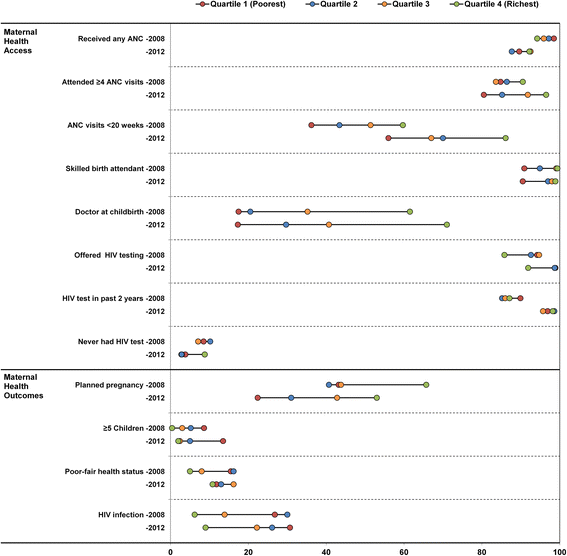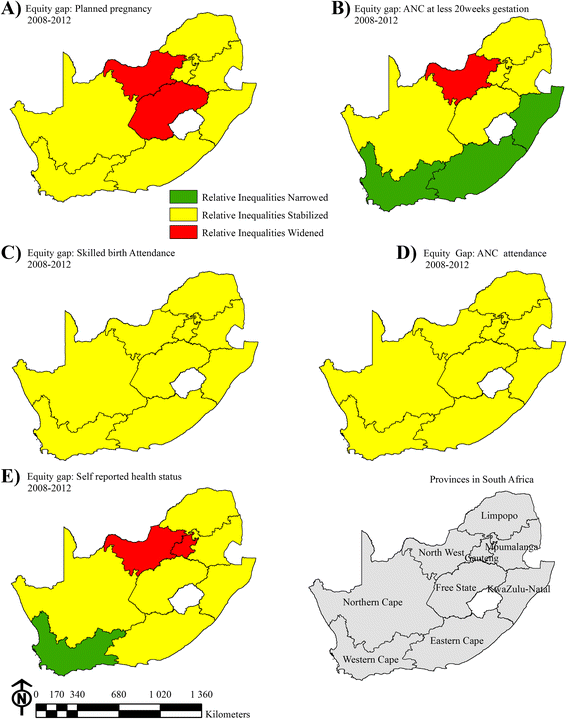Growing inequities in maternal health in South Africa: a comparison of serial national household surveys
- PMID: 27581489
- PMCID: PMC5007803
- DOI: 10.1186/s12884-016-1048-z
Growing inequities in maternal health in South Africa: a comparison of serial national household surveys
Abstract
Background: Rates of maternal mortality and morbidity vary markedly, both between and within countries. Documenting these variations, in a very unequal society like South Africa, provides useful information to direct initiatives to improve services. The study describes inequalities over time in access to maternal health services in South Africa, and identifies differences in maternal health outcomes between population groups and across geographical areas.
Methods: Data were analysed from serial population-level household surveys that applied multistage-stratified sampling. Access to maternal health services and health outcomes in 2008 (n = 1121) were compared with those in 2012 (n = 1648). Differences between socio-economic quartiles were quantified using the relative (RII) and slope (SII) index of inequality, based on survey weights.
Results: High levels of inequalities were noted in most measures of service access in both 2008 and 2012. Inequalities between socio-economic quartiles worsened over time in antenatal clinic attendance, with overall coverage falling from 97.0 to 90.2 %. Nationally, skilled birth attendance remained about 95 %, with persistent high inequalities (SII = 0.11, RII = 1.12 in 2012). In 2012, having a doctor present at childbirth was higher than in 2008 (34.4 % versus 27.8 %), but inequalities worsened. Countrywide, levels of planned pregnancy declined from 44.6 % in 2008 to 34.7 % in 2012. The RII and SII rose over this period and in 2012, only 22.4 % of the poorest quartile had a planned pregnancy. HIV testing increased substantially by 2012, though remains low in groups with a high HIV prevalence, such as women in rural formal areas, and from Gauteng and Mpumalanga provinces. Marked deficiencies in service access were noted in the Eastern Cape ad North West provinces.
Conclusions: Though some population-level improvements occurred in access to services, inequalities generally worsened. Low levels of planned pregnancy, antenatal clinic access and having a doctor present at childbirth among poor women are of most concern. Policy makers should carefully balance efforts to increase service access nationally, against the need for programs targeting underserved populations.
Keywords: Access; Equity gap; Maternal health; National household survey; Relative inequalities; South Africa.
Figures


Similar articles
-
Equity in maternal health in South Africa: analysis of health service access and health status in a national household survey.PLoS One. 2013 Sep 6;8(9):e73864. doi: 10.1371/journal.pone.0073864. eCollection 2013. PLoS One. 2013. PMID: 24040097 Free PMC article.
-
Effective coverage for reproductive, maternal, neonatal and newborn health: an analysis of geographical and socioeconomic inequalities in 39 low- and middle-income countries.BMJ Glob Health. 2025 Feb 17;10(2):e016549. doi: 10.1136/bmjgh-2024-016549. BMJ Glob Health. 2025. PMID: 39961692 Free PMC article.
-
Similarities in socioeconomic disparities and inequalities in women's nutritional status and health care in Bangladesh, Ethiopia, India, and Nigeria.Glob Health Action. 2024 Dec 31;17(1):2439165. doi: 10.1080/16549716.2024.2439165. Epub 2025 Jan 17. Glob Health Action. 2024. PMID: 39819442 Free PMC article.
-
Large and persistent subnational inequalities in reproductive, maternal, newborn and child health intervention coverage in sub-Saharan Africa.BMJ Glob Health. 2020 Jan 26;5(1):e002232. doi: 10.1136/bmjgh-2019-002232. eCollection 2020. BMJ Glob Health. 2020. PMID: 32133183 Free PMC article. Review.
-
Measuring coverage in MNCH: determining and interpreting inequalities in coverage of maternal, newborn, and child health interventions.PLoS Med. 2013;10(5):e1001390. doi: 10.1371/journal.pmed.1001390. Epub 2013 May 7. PLoS Med. 2013. PMID: 23667332 Free PMC article. Review.
Cited by
-
The rise and fall of mortality inequality in South Africa in the HIV era.SSM Popul Health. 2018 Jun 21;5:239-248. doi: 10.1016/j.ssmph.2018.06.007. eCollection 2018 Aug. SSM Popul Health. 2018. PMID: 30094319 Free PMC article.
-
Impact of COVID-19 on maternal healthcare in Africa and the way forward.Arch Public Health. 2021 Dec 10;79(1):223. doi: 10.1186/s13690-021-00746-6. Arch Public Health. 2021. PMID: 34886893 Free PMC article.
-
Reflections on Digital Maternal and Child Health Support for Mothers and Community Health Workers in Rural Areas of Limpopo Province, South Africa.Int J Environ Res Public Health. 2023 Jan 19;20(3):1842. doi: 10.3390/ijerph20031842. Int J Environ Res Public Health. 2023. PMID: 36767230 Free PMC article.
-
The role of a community health worker-delivered preconception and pregnancy intervention in achieving a more positive pregnancy experience: the Bukhali trial in Soweto, South Africa.BMC Womens Health. 2024 Mar 5;24(1):161. doi: 10.1186/s12905-024-02982-8. BMC Womens Health. 2024. PMID: 38443924 Free PMC article. Clinical Trial.
-
Inequality in Utilization of Maternal Healthcare Services in Low‑ and Middle‑Income Countries: A Scoping Review of the Literature.Matern Child Health J. 2025 Jun;29(6):741-766. doi: 10.1007/s10995-025-04111-9. Epub 2025 Jun 3. Matern Child Health J. 2025. PMID: 40461773 Free PMC article.
References
-
- The World Bank. Income share. 2011.
-
- Massyn N, Day C, Peer N, Padarath A, Barron P. District Health Barometer 2013/14. Durban; 2014.
-
- National Department of Health. The 2012 National Antenatal Sentinel HIV & Herpes Simplex Type-2 Prevalence Survey in South Africa. 2013.
-
- Department of Health. Saving Mothers: Tenth interim report on Confidential Enquiries into Maternal deaths 2011–2012. Pretoria; 2013.
Publication types
MeSH terms
Grants and funding
LinkOut - more resources
Full Text Sources
Other Literature Sources
Medical
Miscellaneous

